9 Nov 2009
WINTER HOLIDAYS ~
Let There Be LIGHT
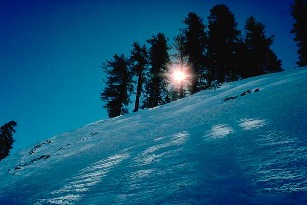
December is the month with the longest nights and so, the holidays that fall at this time have a common theme of celebrating LIGHT--candles, sun worship, bonfires, decorating with bright berries and plants or greens. All these symbolize LIFE that will re-emerge-the Yang to winter's Yin. Winter Solstice, on December 21, is the point in our journey through teh solar system when our days begin to get longer. It happens so slowly we do not notice it, but our celebrations mirror that change and allow us to take part in this quiet, subtle event. The plants associated with winter are so ingrained in the various traditions we practice, that none of the holidays could be observed without them. The sights and smells and tastes of them are healing in their own right, but there is so much more to why each plant has become so integral to the holidays.....
CHANUKAH ~ The Festival of Lights, this Jewish holiday commemorates Jewish cultural survival and the "miracle" that took place at the temple where the lamp (chanukiah), having only enough oil to burn one night, instead burned for 8. So, what herbs are involved here? Olives and potatoes. Today, most menorahs burn candles, though many still use ones designed to burn olive oil. Still, it is a mitzvah-good deed-to use olive oil this week, so instead of burning it, most people fry Latkes-potatoe pancakes . Olive oil keeps skin and hair in good condition during cold weather--and it helps all body systems function well in a part of the year where we exercise less and eat more. Potatoes are a carbohydrate that give us an energy boost--and if eaten WITH the skins, do not have negative affects on blood sugar. Latkes also usually have carrots and onions mixed in as well--offering Vit. A for lung/sinus tissue health and immune system building- especially for respiratory conditions. Latkes are eaten with applesauce and/or sour cream. Apples serve to ease digestion of fats and help maintain health...and sour cream....is just plain yummy. Seriously, the souring process makes it a valuable dairy product that also builds immunity as it is partially fermented--MODERATION!! . Olive oil keeps skin and hair in good condition during cold weather--and it helps all body systems function well in a part of the year where we exercise less and eat more. Potatoes are a carbohydrate that give us an energy boost--and if eaten WITH the skins, do not have negative affects on blood sugar. Latkes also usually have carrots and onions mixed in as well--offering Vit. A for lung/sinus tissue health and immune system building- especially for respiratory conditions. Latkes are eaten with applesauce and/or sour cream. Apples serve to ease digestion of fats and help maintain health...and sour cream....is just plain yummy. Seriously, the souring process makes it a valuable dairy product that also builds immunity as it is partially fermented--MODERATION!!
KWANZAA ~ This new holiday was conceived in the 1960s as a way to reconnect African 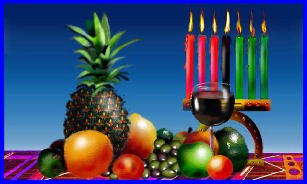 Americans with their heritage. It takes place right after Christmas and also employs light (candle s lit for seven nights) and the use of fruits/vegetables as symbols of moral traits Americans with their heritage. It takes place right after Christmas and also employs light (candle s lit for seven nights) and the use of fruits/vegetables as symbols of moral traits
YULE/CHRISTMAS/SOLSTICE ~ Is it the decorations or the foods that make winter holidays special? BOTH! Herbs and spices make it all possible--and enjoyable!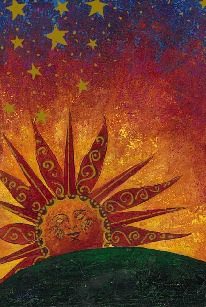
Greens ~ Pine/Cedar boughs, Juniper, Virginia Creeper...these all are evergreens and show their green in the midst of snow and cold--when everything else is brown and dead. So, they have come to symbolize eternal life. The best example of this is the weaving of wreaths-round-to show life is never ending . Or, we hang long ropes of greens over doorways, on bannisters, arrange sprigs in vases and....hang swags on the porch and front/barn doors. And...of course, the Christmas Tree. What a strange and elaborate thing, to bring a full grown tree into your home! It all looks very nice, but the REAL reason we do this is because our ancestors felt the need to remind the spirits/gods/faeries to bring back the warmth of the growing seasons--and to make things look nice for them--to show our appreciation for their continued support. These traditions sprang up in all parts of th eworld where some sort of evergreen plant existed--amongst the Egyptians, The Roman's festival of Saturnalia and with the Druids. Aside from all that and as we now have come to realize, all these plants, with their strong scents and compliments of nutrients, protect us and our livestock from germs (bad spirits). As those smells permeate the air, bacteria finds an unhospitable home. To hang greens in the doorway is an attempt to keep germs out to begin with. But, if they should enter--all these same plants also tend to contain lots of Vitamin C (teas of pine needles, juniper berries are known disease fighters). Thuja oil-from Cedar, works as well as Tea Tree Oil as a topical infection/fungal fighter. . Or, we hang long ropes of greens over doorways, on bannisters, arrange sprigs in vases and....hang swags on the porch and front/barn doors. And...of course, the Christmas Tree. What a strange and elaborate thing, to bring a full grown tree into your home! It all looks very nice, but the REAL reason we do this is because our ancestors felt the need to remind the spirits/gods/faeries to bring back the warmth of the growing seasons--and to make things look nice for them--to show our appreciation for their continued support. These traditions sprang up in all parts of th eworld where some sort of evergreen plant existed--amongst the Egyptians, The Roman's festival of Saturnalia and with the Druids. Aside from all that and as we now have come to realize, all these plants, with their strong scents and compliments of nutrients, protect us and our livestock from germs (bad spirits). As those smells permeate the air, bacteria finds an unhospitable home. To hang greens in the doorway is an attempt to keep germs out to begin with. But, if they should enter--all these same plants also tend to contain lots of Vitamin C (teas of pine needles, juniper berries are known disease fighters). Thuja oil-from Cedar, works as well as Tea Tree Oil as a topical infection/fungal fighter.
The Pine tree, in particular has its own legend- of giving shelter to Mary and Jesus as they fled Herrod's soldiers. Afterward, Jesus blessed the tree and you can see the imprint of his small hand in pinecones which are cut open lengthwise. Similar legends regarding other plants help reinforce the use of certain plants--for religious purposes, but also for health reasons. Our beliefs, traditions, health and general wellbeing are all tied so tightly together and the most positive results are regular celebrations where people come together to socialize--and eat.
HOLLY & IVY ~ Two more evergreens, but that have garnered a special place in our  hearts/minds ~ "Christmastide comes in like a bride, with Holly & Ivy clad" ~ Legend says holly sprung up under the footsteps of Jesus--thorns and berries symbols of blood and suffering--sometimes called "Christ's Thorn". The bark and leaves have been used in times past for contagious diseases, fevers, lung conditions. externally, as fomentations for arthritis and broken bones. The berries are generally toxic--except to birds hearts/minds ~ "Christmastide comes in like a bride, with Holly & Ivy clad" ~ Legend says holly sprung up under the footsteps of Jesus--thorns and berries symbols of blood and suffering--sometimes called "Christ's Thorn". The bark and leaves have been used in times past for contagious diseases, fevers, lung conditions. externally, as fomentations for arthritis and broken bones. The berries are generally toxic--except to birds
Ivy was originally forbidden as a Christmas decoration as it was associated closely with Paganism, but its evergreen quality won out. Its soft,flowing nature along with Holly's stiff, prickly stature made them a nice combination of the good/bad of the cold, barren season. Ivy is not commonly used internally, but rather externally as a poultice or compress for sore  bones/muscles. Exceptions were for those who had severe lung problems--or for those suffering extreme hangovers (*I do not endorse using Ivy for this!) bones/muscles. Exceptions were for those who had severe lung problems--or for those suffering extreme hangovers (*I do not endorse using Ivy for this!)

POINSETTIA~ A native of Mexico, this plant has become associated with Christmas due to its bloom time and its large red blooms a symbol of the Star of Bethlehem. This is a considered a toxic plant, though not as poisonous as once thought.
MISTLETOE ~ This parasitic plant live in the tree tops of apple, oak, hawthorn and ash. It has green leaves and white berries. The Druids cut mistletoe ceremoniously and used it in rituals of protection from evil and to usher in the new year--and again, it is an evergreen. Medicinally, it has been used similarly to holly, but with the added usage for epilepsy--but the berries are not used as they cause symptoms that other parts of the plant help relieve. Mistletoe is being studied and used today in a very refined form to help combat certain types of cancers.
FRANKINCENSE & MYRRH ~ Brought to the baby Jesus as gifts from the Magi, these two herbs are actually plant resins--sap that is hardened. Both are very strong anti-bacterials and were always known to promote general health--which is why both were used as money at various times. While used in tincture forms or powders for external use, the most widespread usage now and in the past is as an incense. The smoke of both can kill germs in the air. As with most plants regarded as "keeping evil at bay", the incense became part of religious ceremonies in temples--both pagan and later, Judeo/Christian. Frankincense (Boswellia) is under extreme study for various chronic conditions-including cancer.
WINTER FRUITS ~ Oranges and Pomegranates are newer to our holiday tables due to the wonders of trade and shipping--but both contain lots of Vit. C, and are bright. Pomagranate seeds are a wonderful slightly tart addition to salads.This is another plant under study for a wide range of health benefits to the heart, breast cancer prevention, immune system issues. The numerous seeds in both fruits indicate fertility/life.
CHRISTMAS SPICES ~ 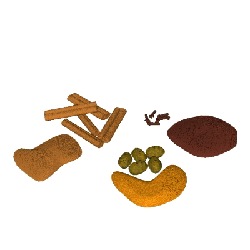 Cinnamon, nutmeg, cloves, ginger, allspice.....the scents are loved by all, the taste is loved by most..It is always fantastic when your medicine tastes good! Do not forget that the Egyptians used these spices for mummification and others used it also for food preservation. The strong scents indicate the anti-bacterial properties that kill food bourne germs as well as those that decay bodies....and...cause contagious illness. Widespread use in cooking came because it was recognized these herbs did a few things--helped digest fats that were needed in a winter diet to keep warm, provided increased circulation to fight off fevers/illness--and to keep warm and the food could be kept around for quite a while --a really nice feature before refrigeration. Use first sprang up in warmer climates though, where the main concern was spoilage and keeping cool! The increased blood flow, in a hot climate will help you sweat--the same mechanism that breaks a fever. Nutmegs are poisonous in a medium dose, but in small amounts, act to fight germs by building immunity. In our foods, cooks know that a little nutmeg is great, too much spoils the taste of a dish. Cinnamon is now recognized as a blood sugar stabilizer and all of these spices aid the circulatory system. World exploration and wars were CAUSED by the pursuit of spices for these very purposes. What you can now buy for pennies an ounce used to cost fortunes. In the end, it has worked out for all of us- no matter where we live. These spices define the winter holidays. Cinnamon, nutmeg, cloves, ginger, allspice.....the scents are loved by all, the taste is loved by most..It is always fantastic when your medicine tastes good! Do not forget that the Egyptians used these spices for mummification and others used it also for food preservation. The strong scents indicate the anti-bacterial properties that kill food bourne germs as well as those that decay bodies....and...cause contagious illness. Widespread use in cooking came because it was recognized these herbs did a few things--helped digest fats that were needed in a winter diet to keep warm, provided increased circulation to fight off fevers/illness--and to keep warm and the food could be kept around for quite a while --a really nice feature before refrigeration. Use first sprang up in warmer climates though, where the main concern was spoilage and keeping cool! The increased blood flow, in a hot climate will help you sweat--the same mechanism that breaks a fever. Nutmegs are poisonous in a medium dose, but in small amounts, act to fight germs by building immunity. In our foods, cooks know that a little nutmeg is great, too much spoils the taste of a dish. Cinnamon is now recognized as a blood sugar stabilizer and all of these spices aid the circulatory system. World exploration and wars were CAUSED by the pursuit of spices for these very purposes. What you can now buy for pennies an ounce used to cost fortunes. In the end, it has worked out for all of us- no matter where we live. These spices define the winter holidays.
This truly is the season to eat, drink and be merry. Give gifts of foods or herbal crafts.... and what better gift than one that tastes good, looks good or makes you smile---and maintains health at the same time? It also is a time we can reconnect to our ancestors in a very instinctual way--because we use the same plants they did--for the same reasons. Much has changed..and much has not. Celebrations and traditions keep us in tune with those things that remain the same.... always. HAPPY HOLIDAYS !!
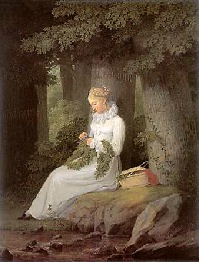
|